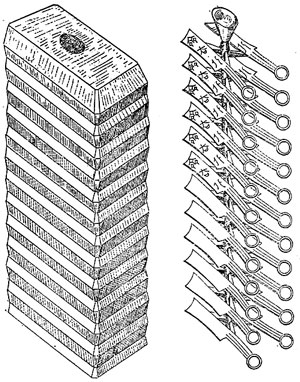The
casting of coins during the
Spring-autumn and Warring States |
The earliest coin moulds which have been found, are
spade- and knife coin moulds from the Spring-Autumn and Warring States period.
The earliest coin moulds were carved in clay, stone or bronze. The inscriptions were in intaglio and they were
used for the actual casting. The clay moulds could be used only one time, the
stone- and bronze moulds could be used several times. Since the clay moulds were destroyed after the casting,
this has been a slow an expensive way of producing coins. Soft stone types were used
for stone moulds since hard stone would crack, because of the high shift in
temperatures during the casting. The type of mould shown below, had to be
destroyed after the casting, in order to release the coins. Stone moulds were not
destroyed, and had a shape, which allowed the mould to be opened and
used again. The early carved bronze moulds could be used for the actual casting
and were not mother moulds. The ant nose money of the Chu state
is an example of direct casting in carved bronze moulds (A Xing p. 67). I
have not been able to find an explanation to why direct casting in bronze
moulds were only used in this period and not later on. If Bronze could be used for direct casting,
one should think it would have been preferred to clay and stone, since it was
more durable. My own guess is, that there must have been problems releasing the
coins after casting. The ant nose money are very simple and crude coins with
inscriptions in intaglio, maybe it was possible to cast this shape in bronze
moulds, but not the more sophisticated designs with rims, holes and inscriptions in
relief.
Later moulds from this period were usually made
from clay. The mould used for the actual casting was called a child mould
(fig. 2). The
child mould was made with a so-called mother mould (fig. 1). The mother moulds
could be made of clay, stone or bronze.
The clay child molds had tenons, that fit into the opposite part of the mould,
to keep the two parts aligned. This kind of moulds had half the
impression on each side, but some types of coins were cast in moulds where only
the obverse was impressed. In that case, the reverse side of the mould was a completely flat
polished stone or brick. All the round coins shown on the Warring
States page are cast with this method.
The child moulds were piled and covered with a clay sheath to keep the
assembly together. The moulds of the Han were baked before casting, and moulds were
likely also baked in earlier times, since the clay would probably crack during
the casting, if they were only sun-dried.


Fig. 1. Mother
mould
Fig. 2. A pile of child moulds Fig. 3. The cast knife
coins before
they were broken apart.
Illustrations from Tang, Wenguang: Wo Guo Gudai Jizhong Huobi de Zhuzao Jishu.
Zhong Yuan Wenwu, 1983 nr. 2, p. 75, 76.


